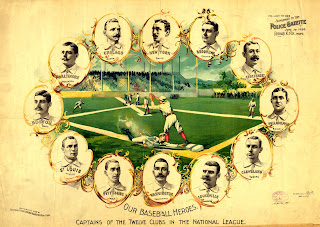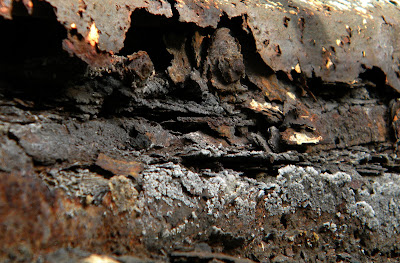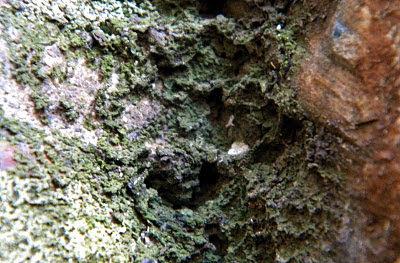Still the Giant came on so fast that he was quite close to poor Jack, and had stretched out his great hand to catch him. But, luckily, just at that moment he stepped upon a loose stone, stumbled, and fell flat on the ground, where he lay at his full length.
This accident gave Jack time to get on the Beanstalk and hasten down it; but just as he reached their own garden he beheld the Giant descending after him.
'Mother! mother!' cried Jack, 'make haste and give me the axe.'
His mother ran to him with a hatchet in her hand, and Jack with one tremendous blow cut through all the Beanstalks except one.
'Now, mother, stand out of the way!' said he.
The Giant Breaks His Nece.
Jack's mother shrank back, and it was well she did so, for just as the Giant took hold of the last branch of the Beanstalk, Jack cut the stem quite through and darted from the spot.
Down came the Giant with a terrible crash, and as he fell on his head, he broke his neck, and lay dead at the feet of the woman he had so much injured.
Before Jack and his mother had recovered from their alarm and agitation, a beautiful lady stood before them.

Jack,' said she, 'you have acted like a brave knight's son, and deserve to have your inheritance restored to you. Dig a grave and bury the Giant, and then go and kill the Giantess.'
'But,' said Jack, 'I could not kill anyone unless I were fighting with him; and I could not draw my sword upon a woman. Moreover, the Giantess was very kind to me.' The Fairy smiled on Jack.
'I am very much pleased with your generous feeling,' she said. 'Nevertheless, return to the castle, and act as you will find needful.'
Jack asked the Fairy if she would show him the way to the castle, as the Beanstalk was now down. She told him that she would drive him there in her chariot, which was drawn by two peacocks. Jack thanked her, and sat down in the chariot with her.
The Fairy drove him a long distance round, till they reached a village which lay at the bottom of the hill. Here they found a number of miserable-looking men assembled. The Fairy stopped her carriage and addressed them:
'My friends,' said she, 'the cruel giant who oppressed you and ate up all your flocks and herds is dead, and this young gentleman was the means of your being delivered from him, and is the son of your kind old master, the knight.'
The men gave a loud cheer at these words, and pressed forward to say that they would serve Jack as faithfully as they had served his father. The Fairy bade them follow her to the castle, and they marched thither in a body, and Jack blew the horn and demanded admittance.
The old Giantess saw them coming from the turret loop-hole. She was very much frightened, for she guessed that something had happened to her husband; and as she came downstairs very fast she caught her foot in her dress, and fell from the top to the bottom and broke her neck.
When the people outside found that the door was not opened to them, they took crowbars and forced the portal. Nobody was to be seen, but on leaving the hall they found the body of the Giantess at the foot of the stairs.
Thus Jack took possession of the castle. The Fairy went and brought his mother to him, with the hen and the harp. He had the Giantess buried, and endeavoured as much as lay in his power to do right to those whom the Giant had robbed.
Before her departure for fairyland, the Fairy explained to Jack that she had sent the butcher to meet him with the beans, in order to try what sort of lad he was.
If you had looked at the gigantic Beanstalk and only stupidly wondered about it,' she said, 'I should have left you where misfortune had placed you, only restoring her cow to your mother. But you showed an inquiring mind, and great courage and enterprise, therefore you deserve to rise; and when you mounted the Beanstalk you climbed the Ladder of Fortune.'
She then took her leave of Jack and his mother.
This Image (or other media file) is in the public domain because its copyright has expired. This applies to the United States, where Works published prior to 1978 were copyright protected for a maximum of 75 years. See
Circular 1 "COPYRIGHT BASICS" PDF from the U.S. Copyright Office. Works published before 1923 in this case 1890, are now in the public domain.
This file is also in the public domain in countries that figure copyright from the date of death of the artist (post mortem auctoris in this case Henry Justice Ford (1860-1941) and Lancelot Speed (1860 – 1931) and that most commonly runs for a period of 50 to 70 years from December 31 of that year.
+sookie texTEXT and IMAGE CREDIT:
The Red fairy book Opie collection of children's literature ; 014:229 Editor: Andrew Lang Edition 2. Publisher: Longmans, Green, 1890. Illustrators: Henry Justice Ford (1860-1941) and Lancelot Speed (1860 – 1931). Original from: the University of Michigan. Digitized: Oct 7, 2008. Length: 367 pages. Subjects: Fiction › Fantasy › General, Children's stories, Fairy tales, Fiction / Fairy Tales, Folklore & Mythology, Fiction / Fantasy / General Social Science / Folklore & Mythology.





































